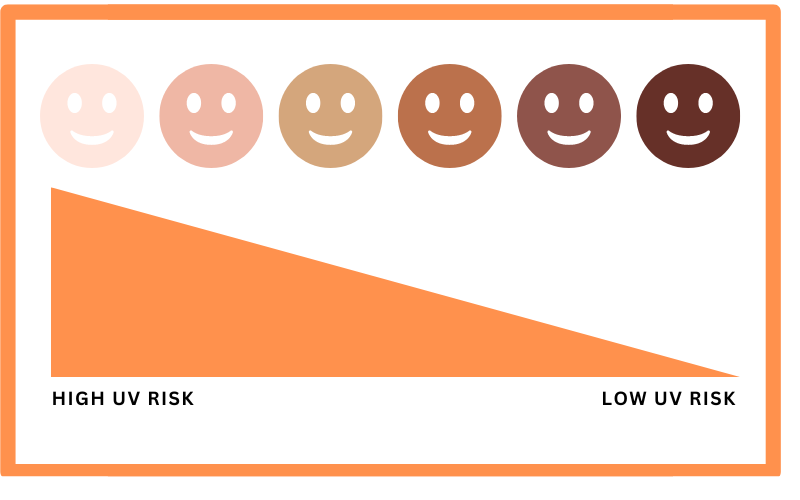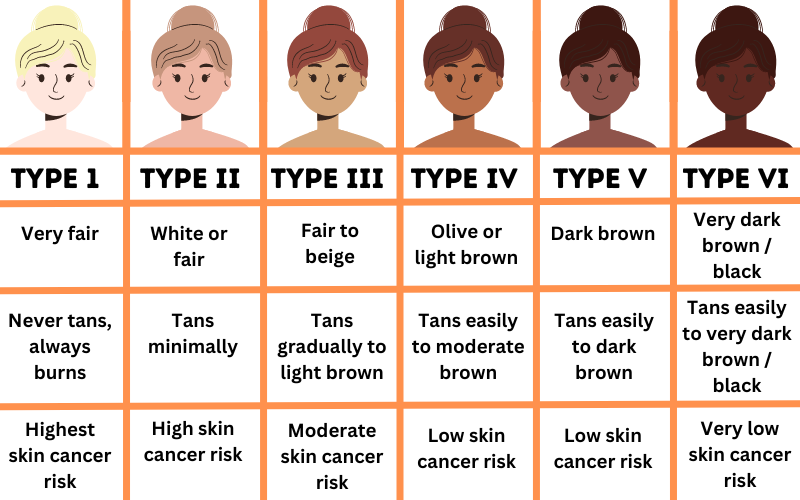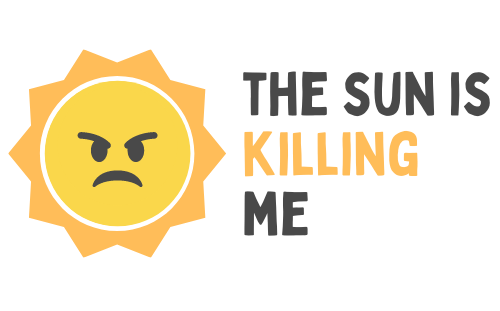The Fitzpatrick skin phototypes are a classification system that categorizes human skin into six different types based on the skin’s response to UV radiation and sun exposure.
This system is widely used in dermatology to determine an individual’s skin cancer risk and to guide the selection of appropriate sun protection measures.
It was first developed in 1975 by Thomas B. Fitzpatrick, M.D., a Harvard Medical School graduate and world-renowned dermatologist.
The six skin types are categorized based on the amount of melanin present in the skin. Type 1 is considered the lightest, having very little melanin production and being highly sensitive to sunburn. Type 6 is the darkest, having a lot of melanin production and being highly resistant to sunburn.
Fitzpatrick Skin Types
Below is a guide to the Fitzpatrick skin phototypes I-VI, with a description of each skin type:
- Fitzpatrick Skin Phototype I: This skin type is characterized by very fair skin that burns easily and never tans. People with skin type I have blue eyes or green eyes and blonde or red hair. They are at the highest risk of developing skin cancer and should take extra precautions to protect their skin from the sun (psst — we have a list of our favorite sunscreens for fair skin if you need some recs).
- Fitzpatrick Skin Phototype II: This skin type is characterized by fair skin that burns easily and tans minimally. People with skin type II have blue-gray or green eyes and blonde or light brown hair. They are also at a relatively high risk of skin cancer, so should also take precautions to protect against sun exposure,
- Fitzpatrick Skin Phototype III: This skin type is characterized by fair skin that sometimes burns, but can also tan gradually to a light brown color. People with skin type III have hazel or green eyes and light to medium brown hair. They are at moderate risk of developing skin cancer and should still take precautions to protect their skin.
- Fitzpatrick Skin Phototype IV: This skin type is characterized by light brown or olive skin that rarely burns and tans easily to a moderate brown color. People with skin type IV have dark brown eyes and dark brown or black hair. They’re skin cancer risk is generally lower, but they should still take precautions to protect their skin from excessive sun exposure.
- Fitzpatrick Skin Phototype V: This skin type is characterized by dark brown skin with more melanin that rarely burns and tans easily to turn dark brown quickly. People with skin type V have dark brown eyes and black hair. Their skin cancer risk is relatively low risk, but sun precautions are still wise.
- Fitzpatrick Skin Phototype VI: This skin type is characterized by very dark brown or black skin that never burns and tans very easily. People with skin type VI have dark brown eyes and black hair. They are the least likely to develop skin cancer, but still need to take precautions to protect their skin.

How Does the Fitzpatrick Scale Evaluate Individuals?
The Fitzpatrick Scale evaluates individuals using a six-point scale, from lighter skin tone (type 1) to darker skin tone (type 6). It takes into account the amount of melanin in the skin and how easily it tans or burns, also affected by hair color, eye color, and the ease (or difficulty) with which one can tan.
It’s designed to help dermatologists and other skin care professionals determine the right treatments for their patients, but it can be helpful for the average person in assessing their own risk of sunburn or skin cancer.
Fitzpatrick Skin Type Chart

Here’s a chart that summarizes the Fitzpatrick scale types:
| Fitzpatrick Skin Phototype | Skin Color | Eye Color | Hair Color | Sunburn Likelihood | Tanning Ability | Skin Cancer Risk |
|---|---|---|---|---|---|---|
| I | Very fair | Blue or green | Blonde or red | Always burns | Never tans | High |
| II | Fair | Blue or green | Blonde or light brown | Burns easily | Tans minimally | High |
| III | Fair to beige | Hazel or green | Light to medium brown | Sometimes burns | Tans gradually to a light brown color | Moderate |
| IV | Olive or light brown | Dark brown | Dark brown or black | Rarely burns | Tans easily to a moderate brown color | Low |
| V | Dark brown | Dark brown | Black | Rarely burns | Tans easily to a dark brown color | Low |
| VI | Very dark brown or black | Dark brown | Black | Never burns | Tans very easily to a very dark brown or black color | Very low |
It’s important to note that this is just a general guide, and individual skin types can vary. People should still take precautions to protect their skin from sun damage regardless of their skin
Issues With the Fitzpatrick Scale Skin Assessment
It is important to note that while the Fitzpatrick scale system is useful in determining sun sensitivity, it primarily focuses on skin color and various shades of human skin pigmentation.
It does not take into account other factors such as geography, age, environmental UV exposure.
Therefore, it is important to remember that regardless of your skin type, everyone should take precautions to protect their skin from sun damage.
It is also important to note that while this system can provide an estimate of the risk of developing skin cancer, it cannot guarantee protection against the disease.
Skin cancer is a serious condition that can have long-term consequences, so it’s recommended to always protect yourself with sunscreen, hats, and clothing when out in the sun — even if you’re not considered especially vulnerable to skin cancer.
Additionally, it’s important to stay up to date on skin checks and visit a doctor if you notice any unusual or concerning changes in your skin.
What Action Should I Take Based on My Type?
Knowing your Fitzpatrick skin type can help you make informed decisions about sun protection, such as selecting appropriate sunscreen products or scheduling outdoor activities during times when UV radiation levels are lowest.
While it’s not perfect, the Fitzpatrick scale remains a useful tool for learning about your skin type based on your skin color, eyes, and hair shade, and understanding your associated risk of skin cancer.
It’s important to remember that even if you fall into a lower-risk category, everyone should take precautions to protect their skin from the sun’s rays.
FAQ About the Fitzpatrick Scale
What Should I Do if I’m Type I?
If you have type I skin according to the Fitzpatrick scale, you are one of the very sensitive sun-reactive skin types and should take extra precautions to protect your skin from sun exposure.
This includes wearing a broad-spectrum sunscreen with an SPF of 30 or higher on any exposed areas, as well as covering up with hats, clothing, and sunglasses when out in the sun. You’ll need to be fastidious about keep up with sunscreen application and re-applying regularly, as you are generally more prone to sunburns and skin cancer.
Consider using tools like UV apps to help track your level of exposure to UV rays at various times of the day, and consider staying in the shade during peak hours — usually between 10 am and 4 pm.
You may also want to consider using sun-detecting stickers which change color when they have been exposed to too much UV radiation, helping you better keep up with sunscreen re-application.
How do I know my Fitzpatrick skin type?
The best way to determine your Fitzpatrick skin type is to get a professional opinion from a dermatologist. A dermatologist can assess your skin’s response to UV radiation and assign you the appropriate Fitzpatrick skin phototype category.
How many Fitzpatrick skin types are there?
There are six Fitzpatrick skin types, ranging from type I to VI. Type I is the lightest and most sensitive to sunburns, while type VI is the darkest and least affected by the sun.
What happens if you have a higher Fitzpatrick skin type?
Having a higher Fitzpatrick skin type may mean that you are at lower risk of developing skin cancer. However, it is still important to take precautions to protect your skin from sun damage by wearing sunscreen and protective clothing when outdoors. Remember, while skin cancer is less common in darker skin tones, it still does happen and can be deadly, so it’s always worth taking precautions.
What are the six Fitzpatrick skin types?
The six Fitzpatrick skin types are:
Type I : Very fair skin, always burns easily and rarely tans.
Type II : Fair, pale skin, burns easily and tans with difficulty.
Type III : Medium, light brown skin, sometimes burns and tans to darker skin gradually.
Type IV : Dark brown skin, rarely burns and tans easily.
Type V : Darker brown skin, rarely burns and tans easily.
Type VI : Very dark skin, never burns and always very deeply pigmented.
What ethnicity is Fitzpatrick skin type 6?
Fitzpatrick skin type 6 is typically associated with people of African, Middle Eastern, and South Asian descent who have deeply pigmented, dark skin.
However, it is important to note that the skin scale doesn’t determine ethnicity or race; rather, it is an indication of how your skin responds to UV radiation. People of any ethnic background can have this skin type.
What ethnicity is Fitzpatrick skin type 5?
Fitzpatrick skin type 5 is typically associated with people of African, Indian, and Hispanic descent with dark brown pigment in their skin.
However, these skin types are not exclusive to a single ethnic or racial group—people of all backgrounds can fall into any Fitzpatrick skin type category.
What ethnicity is Fitzpatrick skin type 4?
Type IV Fitzpatrick skin is typically found in individuals with a Mediterranean or Middle Eastern background, as well as some African Americans.
But, remember that skin type is determined by several factors and can vary widely between people of the same ethnicity.
What ethnicity is Fitzpatrick skin type 3?
Type III Fitzpatrick skin is typically found in individuals with lighter skin tones, such as those of Caucasian, Hispanic, and Middle Eastern descent. That being said, skin type is determined by several factors and can vary widely between people of the same ethnicity.
What ethnicity is Fitzpatrick skin type 2?
Type II Fitzpatrick skin is typically found in individuals with lighter skin tones, such as those of Caucasian, Hispanic, and Middle Eastern descent.
Keep in mind that skin type isn’t determined by ethnicity alone and can vary widely between people of the same ethnicity.
What ethnicity is Fitzpatrick skin type 1?
Type I Fitzpatrick skin is typically found in individuals with very fair skin tones, such as those of Scandinavian or Northern European descent. However, ethnicity alone is not an appropriate or reliable way to determine one’s skin type. These individuals are more prone to sunburns (and developing freckles even wearing sunscreen).

